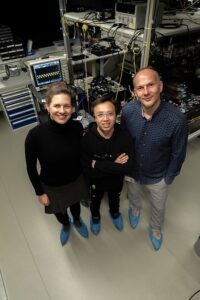A new way of entangling light and sound

Artist’s view of entangled laser light with a traveling sound wave in an integrated photonic waveguide.
Credit: Alexandra Genes
For a wide variety of emerging quantum technologies, such as secure quantum communications and quantum computing, quantum entanglement is a prerequisite. Scientists at the Max-Planck-Institute for the Science of Light (MPL) have now demonstrated a particularly efficient way in which photons can be entangled with acoustic phonons. The researchers were able to demonstrate that this entanglement is resilient to external noise, the usual pitfall of any quantum technology to date. They recently published their research in ›Physical Review Letters‹.

Credit: Susanne Viezens
Quantum entanglement is a phenomenon in which particles become interconnected such that the state of one instantly influences the state of the other, regardless of the distance between them. Entanglement is an important phenomenon for many quantum technology applications because it can lead to secure quantum communications and high-dimensional quantum computing. As photons, quanta of light, can propagate extremely fast while carrying quantum information, the entangling of pairs of photons via nonlinear optics is an established procedure. Scientists at MPL have recently tackled the issue of establishing entanglement between very different entities such as traveling sound waves, phonons, and optical photons. The proposed optoacoustic entanglement scheme is based on Brillouin scattering. It is particularly resilient, suitable for integration into quantum signal processing schemes and implementable at high environmental temperatures.
Einstein called it “spooky action at a distance”. Entanglement has historically been fascinating at many different levels, as it strongly connects to our understanding of the fundamental laws of nature. Quantum correlations among particles can persist even when separated by large distances. At the practical level, quantum entanglement is at the heart of many emerging quantum technologies. In the optical domain, entanglement of photons is fundamental to secure quantum communication methods or quantum computing schemes. Photons, however, are volatile. Therefore, feasible alternatives are being sought for certain applications, such as quantum memory or quantum repeater schemes. One such alternative is the acoustic domain, where quanta are stored in acoustic or sound waves.
Scientists at the MPL have now indicated a particularly efficient way in which photons can be entangled with acoustic phonons: While the two quanta travel along the same photonic structures, the phonons move at a much slower speed. The underlying effect is the optical nonlinear effect known as Brillouin-Mandelstam scattering. It is responsible for coupling quanta at fundamentally different energy scales.
In their study the scientists showed that the proposed entangling scheme can operate at temperatures in the tens of Kelvin. This is much higher than those required by standard approaches, which often employ expensive equipment such as dilution fridges. The possibility of implementing this concept in optical fibers or photonic integrated chips makes this mechanism of particular interest for use in modern quantum technologies.
Journal: Physical Review Letters
DOI: 10.1103/PhysRevLett.133.203602
Method of Research: Experimental study
Subject of Research: Not applicable
Article Title: Optoacoustic Entanglement in a Continuous Brillouin-Active Solid State System
Article Publication Date: 13-Nov-2024
Media Contact
All latest news from the category: Physics and Astronomy
This area deals with the fundamental laws and building blocks of nature and how they interact, the properties and the behavior of matter, and research into space and time and their structures.
innovations-report provides in-depth reports and articles on subjects such as astrophysics, laser technologies, nuclear, quantum, particle and solid-state physics, nanotechnologies, planetary research and findings (Mars, Venus) and developments related to the Hubble Telescope.
Newest articles

First-of-its-kind study uses remote sensing to monitor plastic debris in rivers and lakes
Remote sensing creates a cost-effective solution to monitoring plastic pollution. A first-of-its-kind study from researchers at the University of Minnesota Twin Cities shows how remote sensing can help monitor and…

Laser-based artificial neuron mimics nerve cell functions at lightning speed
With a processing speed a billion times faster than nature, chip-based laser neuron could help advance AI tasks such as pattern recognition and sequence prediction. Researchers have developed a laser-based…

Optimising the processing of plastic waste
Just one look in the yellow bin reveals a colourful jumble of different types of plastic. However, the purer and more uniform plastic waste is, the easier it is to…


